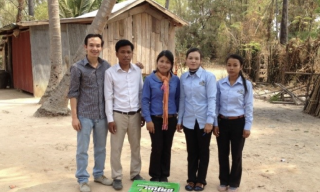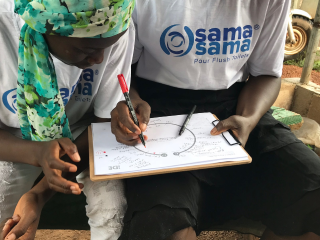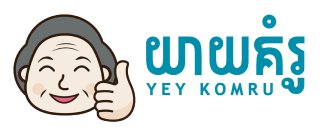Inspiration
Learn how other WASH practitioners have successfully applied HCD tools and methods to increase the impact of their projects across the WASH sectors.
HCD in WATER Projects

Super Tunsai Water Filter Commercial | YouTube, 1 Min
Infiltrating the market with clean water: Case Study | PDF, 6.4MB
Infiltrating the market with clean water: Blog Post | External blogpost, English
Super Tunsai - ceramic water filter by Hydrologic | YouTube, Khmer with English subtitles, 6 minutes
Beginning in 2001, iDE created and incubated the social enterprise Hydrologic with the goal of improving affordable household water treatment options in rural Cambodia. The company became a self-reliant financially independent subsidiary of iDE in 2009 and became profitable in 2012 based on their top-selling Super Tunsai water filter.
The Super Tunsai (Super Rabbit) water filter that is at the core of the Hydrologic sales and impact metrics was designed to respond to user feedback and to the growing demand in rural areas for more aspirational and safe water products.
In partnership with PATH, Hydrologic worked to improve the product function and appearance through an iterative Human-Centered Design approach and community based feedback from diverse end users.
In collaboration with iDE, Hydrologic worked to develop an in-house credit facility with the goal of supplementing the credit available through MFI (Micro Finance Institution) partners and thus lowering the upfront cost barriers for the rural Cambodian customers.
Through collaboration and interdisciplinary teamwork, the following areas are where HCD was most intentionally focused in the water filter development:
Overall this work resulted with modifications that turned the SuperTunsai into a product that is not only desirable, feasible and viable but also aspirational for rural Cambodias in terms of aesthetic, cost and function.
In order to inform their design process, the interdisciplinary Hydrologic team utilized the following tools from the DISCOVER phase:
User Observations: User Observations to determine their patterns and routines particularly as it relates to accessing clean water
User Interviews: to understand their current water/water filter or boiling to uncover the motivations and painpoints regarding accessing clean water and or the desire for filters for rural Cambodian customers (painpoints included time cost, financial cost, labor intensive, getting sick which was the basis for their motivation/demand for Super Tunsai)
The Hydrologic team entered the CREATE phase of HCD to bring the Super Tunsai water filter product from development to commercialization:
They tested physical product Prototype of the filter product with users to inform the aesthetic and packaging.
They tested product and process prototypes for the filter manufacturing to improve operations for lean manufacturing (after uncovering that 30% of products were defective each month)
These steps informed the final product design and product perception of it being desirable, feasible and viable.
To support the sales and marketing approaches, the team continued to refine the business model during the DELIVER phase.
In partnership with Whitten & Roy Partnership (WRP), they created a human-centered sales approach and piloted different distribution channels.This informed the business strategy pivot from retail product channels to B2C channels (door to door with an ‘ethical sales’ approach)
HCD in SANITATION Projects

iDE Ghana: Sama Sama Gender Deep Dive Report | PDF, English, 16MB
Food Security and Nutrition Network: Human-Centered Design Tools for WASH: How Designing With People Strengthens Programming | Webinar, English
Sama Sama is a sanitation social enterprise that was founded in 2016 and sells pour-flush latrines across 31 districts of Ghana. Leveraging Sama Sama’s existing network, operations, and reach, iDE explored how to best increase women’s ability to participate in sanitation value chains across the country by conducting research rooted in human-centered design methodologies.
Empowering women to participate in the sanitation supply chain, can have significant impacts on changing systemic gender inequalities. However, there is limited research on these topics in the African context.
By utilizing HCD, iDE worked to discover opportunities and challenges for women: 1) working in the Sama Sama social enterprise, 2) for women toilet business co-owners, 3) for Sama Sama women customers, and 4) for Sama Sama latrine end users.
In the CREATE phase the team worked to design tools and techniques to support women 1) Sama Sama enterprise women employees, 2) toilet businesses women owners, and 3) to improve the use of latrines by people of all genders and ages. Notably, as a co-creation tool, the team used the Multilane Highway Tool which allows multi-stakeholder participation to determine where all the stakeholders start on the road relative to the problem and the final goals of gender equality and improved sanitation.
In order to fully understand the barriers that exist for women in the sanitation value chain, the iDE utilized the following HCD tools (with user consent) for the DISCOVER phase of this work:
Interviews to understand their current sanitation reality, their use of the Sama Sama latrine product, their main sanitation motivations, and their main challenges.
The Day in the Life tool was used to understand the day in the life of the various latrine users (to help codify their stories that were told)
The Who’s Responsible tool was used to help visualize the user’s perceptions and beliefs around the sanitation value chain such as determining who is responsible for cleaning a toilet vs purchasing a toilet)
The Journey Mapping tool was used to help understand how the toilet fits into the life of the different users and how they interact with it, feel about it, or need it.
Observations to determine their patterns and routines particularly as it relates to WASH
In the CREATE phase the team worked to design tools and techniques to support women 1) Sama Sama enterprise women employees, 2) toilet businesses women owners, and 3) to improve the use of latrines by people of all genders and ages. Notably, as a co-creation tool, the team used the Multilane Highway tool which allows multi-stakeholder participation to determine where all the stakeholders start on the road relative to the problem and the final goals of gender equality and improved sanitation.
Using the insights uncovered, the Sama Sama team employed a multi-prong strategy to embed gender equality through all levels of the organization. In order to reach customers of all genders, sales agents adjusted their promotion strategies, ensuring they found women at the market. An outcome of this process was the need for organization-wide gender training sessions and associated action plans to reinforce the lessons learned in those trainings. The action plans focus on ensuring that employees of all genders have the opportunities for work life balance, professional growth within the organization, and pay equity.
Sama Sama has also created the Women's Empowerment Network (WEN), which serves as a space for female employees to support one another. The network invites both external speakers and Sama Sama staff to reflect on their experiences as professional women in often male-dominated industries and are known to host meaningful conversations. Many women employees run separate businesses outside of work hours, and point to the WEN as one of the reasons they were able to start this additional income stream for their families.
In 2022, Sama Sama invested in an onsite nursery with a full time nanny to allow mothers to show up at work, knowing their little ones are close by and can easily be checked on during the day.
HCD in HYGIENE Projects

Yey Komru - Handwashing BCC | Facebook Video, Khmer with English subtitles
iDE Cambodia: Inspiring grandmothers to lead the way towards WASH behavior change | PDF, English, 2.5MB
Yey Komru - Website | External link, English and Khmer
iDE Innovation Lab sought to improve the WASH realities in Cambodia by creating a child-centered behavior change campaign that emerged from HCD methods and research. Their work followed these steps:
DISCOVER: Exploring the problem - talking to the community to get a deeper understanding of the problem
CREATE: Finding a focus - identifying and prototyping social behavior change communications to fill a critical gap in child-focused WASH interventions for caregivers with children between 2-5 years old and identifying the underlying motivations and triggers
DELIVER: The solution - rolling out a national Social Behavior Change (SBC) campaign called Yey Komru (“Role Model Grandmother”) to promote improved child-centered WASH behaviors that had diverse open source toolkits for any organization to adopt, it aims to improve the overall health outcomes of children and contribute to the reduction of stunting in Cambodia.
The iDE Cambodia Innovation Lab utilized the following HCD tools in the DISCOVER phase of this work:
User Interviews: to understand their current handwashing reality, their main hygiene motivations, and their main handwashing and hygiene challenges. These interviews were held with diverse stakeholders like caregivers, household members, healthcare workers, local authority figures and other key focal points/stakeholders.
Literature Reviews: to understand past research and related precedents or proxies in handwashing behavior change work
Alignment Workshop: with WASH and Nutrition experts to assess existing knowledge, solutions and gaps around this topic.
Following data collection, the team synthesized findings to inform the CREATE phase. During this process, the research team learned that the 2-5 years age range is critical and typically overlooked by caregivers for hygiene related behavior. Additionally, there is limited information for caregivers about how to enable positive hygiene behaviors with young children.
The team then transitioned in the CREATE phase of the HCD process which entailed the following:
Co-creating, rapidly prototyping, and piloting an effective SBC campaign with the project stakeholders/community based on their learnings
This includes the creation of the campaign’s focus as “Yey Komru” (meaning “Role Model Grandmother” in Khmer). Yey Komru is an aspirational grandmother who sets a positive example for caregivers in rural Cambodia to follow. Her name and identity was created by caregivers themselves during iterative fieldwork tests to best resonate with the community.
Iterating the campaign based on community-based feedback
After 18 months of research and development, the team launched final version of the Yey Komru campaign
The final Yey Komru campaign that was DELIVERED as a result of the DISCOVER and CREATE phases includes 3 approaches to enable and empower caretakers in supporting their children in washing their hands:
Mass media to raise awareness about handwashing on platforms like popular TV channels
Interpersonal communications tools as a training of the trainers channel to equip implementors to teach these handwashing behaviors to caregivers
A solution pathway to create champions for handwashing and hygiene in order to facilitate an enabling environment for the Yey Komru campaign to succeed

